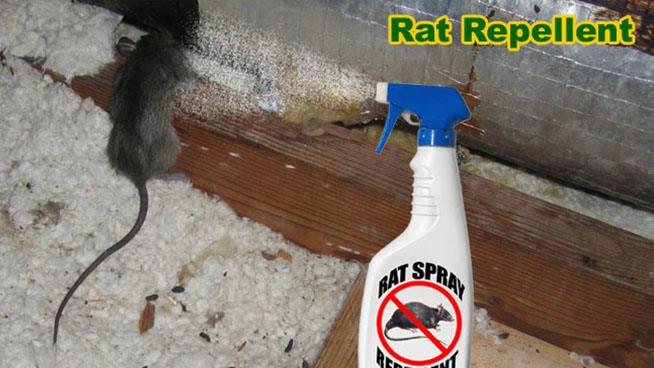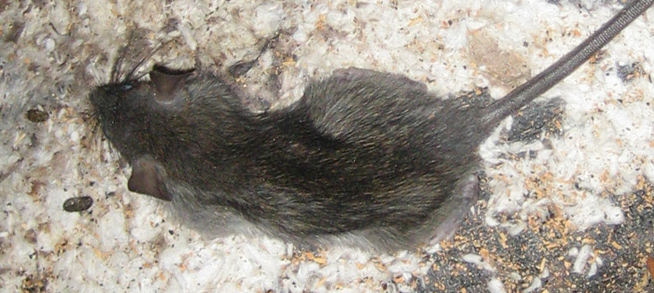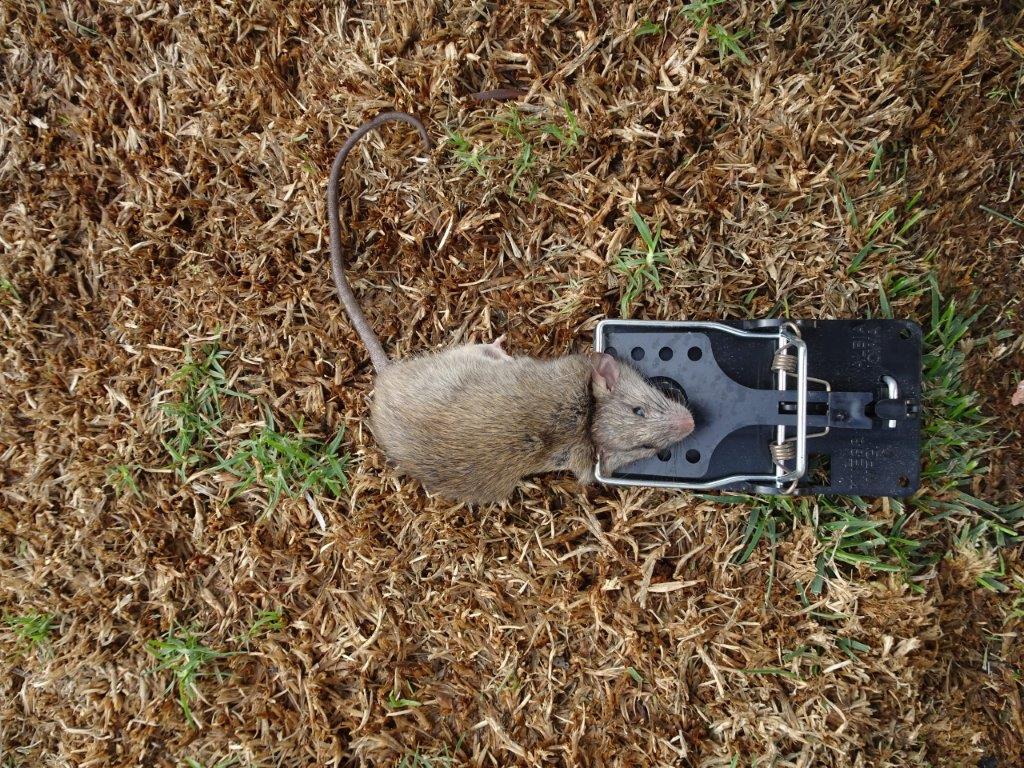I've had the chance to actually see, in the trenches, hundreds of cases of rat infestation in homes, commercial buildings, attics, etc. People really
want to get rid of rat problems, and they don't always know the right way - so in many cases, people try to use a repellent - a scent device that they've
read or hear that rats don't like, and which will get them to leave.

There are many rat repellent sprays, powders, granules, etc, marketed and sold.
Here's the deal with a simple scent repellent - you're asking an animal, such as a rat, to leave the only home it knows, its only key to survival, just because of some smell? If a rat has to vacate the attic and try to live somewhere else, it will almost certainly not survive. Rats know this. It's a rat-eat-rat world out there, with strong competition for space, and rats maintain a vast array of micro-territories. Just like humans, and all other animals. You can't just move into another animal's space. A rat cannot afford to leave its only home (your attic) just because it doesn't like a particular smell. And not only that, in dozens, maybe 100 or more cases that I've seen of people using rat repellents, I've never observed the rats to care in the slightest! The smells don't even seem to bother them, let alone drive them out into a homeless world in which they'll die. REPELLENTS ABSOLUTELY DO NOT WORK, I GUARANTEE THAT 100%.
ANALYSIS OF TYPES OF RODENT REPELLENTS
Moth Balls: Moth balls are the most common generic animal repellent sold. A few companies have discovered that they can sell
canisters of this cheap chemical
(it's called naphthalene) and label it as animal repellent. Products with generic names like "Bat-Away", "Snake Repel", "Squirrel Evict", etc. The truth is that I've never
seen it work. I once went in an attic in which a lady dumped 50 pounds (10 5lb. boxes) of mothballs in the attic, and the rodents were still there. Though the scent is
annoying, and can cause headaches, like it did for the lady I just mentioned, it's not close to enough to make an animal leave its only home. The killer here is that
napthalene is a known carcinogen and wreaks havoc on the environment. So go ahead and use mothballs as animal repellent if you want to stink up your house, get headaches, increase your risk for
cancer, poison the environment, and not change rat behavior in any way whatsoever.
Ammonia: Just another strong odor that people think will work. You can list bleach, paint thinner, or cheap scotch here if you want. Doesn't work.
Predator Urine: This is actually an okay theory. Lots of predators eat rats - cats, owls, hawks, coyotes, dogs, bobcats, etc. Surely a rat, if it smells a predator nearby,
will be scared and want to leave, right? Well, the deal is the same - a rat knows that if it leaves its home, its only source of shelter and food in which survival works, it's going
to die. So rats have, for millions of years, lived in environments with predators, and done their best to avoid them. They hide in small spaces, they sit still when they need to,
they run when they need to. But rats and cats live in the same place, and always have. (Why do you think cats started to live around people and thus became domesticated? The food
source urban environments provided - rats). Rats know the score, the risks, and they have always lived in a world LOADED with the urine scent of other animals. It doesn't make them leave.
Peppermint Oil: Here's a good laugh. I did a good experiment with peppermint to prove a point - I baited several of my rat traps with actual peppermint oil as the bait! And yup, guess what -
I CAUGHT SEVERAL RATS WITH PEPPERMINT - just as many as I did with peanut butter as bait - seems they actually LIKE to eat peppermint. I've seen this rodent peppermint repellent myth listed several times on other websites,
and I've seen many customers try (and of course fail with) good old peppermint
to get rid of rats. Uh, yeah - there's just something magical about peppermint that rats don't like. Hey, maybe they don't like spearmint, licorice, orange oil, or parsley, either. Give me a break.
Read about Black pepper and rats.
High-Pitch Noise Machine: I'm tired of writing about these fraudulent machines. The Federal Trade Commission itself has issued a warning against the utter ineffectiveness of these grade-A fraudulent devices,
which of course are marketed toward every animal and insect known to man, just to try to steal people's money. They don't work, I've seen them used dozens of times with zero effectiveness, I don't feel like
expounding any more on ultrasonic sound repellent machines, end of story.

OKAY, IF REPELLENTS DON'T WORK, HOW DO I KEEP RATS AWAY?
I explain how in detail on several of my web pages, such as the Do It Yourself page, but in short, there is no cheap and easy fix. You have to:
- 1 - Find out how they are getting inside your house, and seal those entry holes.
- 2 - Actually trap and remove the rats - they won't just leave on their own!
THE SAME APPLIES TO MICE
Although I wrote this site with rats in mind, such as the Roof Rat and Norway Rat, the same principles apply to other rodents, such as the house mouse. Mice
behave very similarly to rats, they're just smaller. Email me if you have any questions about mouse repellent, deterrents for mice, rodent repellant, etc.
Read more articles about rats:
How to get rats out of a wall
How to keep rats out of my garden
How to keep rats out of my garbage
How to get rats out of the garage
How to get rats out of your car
Do rats live in more urban areas, or wild areas?
Rats in New York subway
How do you remove a rat stuck in a dumpster?
Why are there so many rats in NYC?
How effective are repellents?
There are a number of repellents and deterrents you can try to use to get rats out of the attic, but there is a very high chance that none of them will work. In fact, we would like to bet money on none of them working at all. Let's face it - if these repellents actually worked, no one would have a rat problem. The repellents would have … well, repelled them.
Take moth balls, for example, a so-called rat repellent that has been around for many years. How many times have you laid moth balls around the place? Do you still have rats? Or mice? Or other wild animals and rodents? Do they still come in and around your home or property? We bet the answer is yes, and that's because, as a repellent for many wild animals, tho balls simply do not work.
Ammonia is something else often used to try and repel a number of wild animals, and this is not only ineffective, but also rather dangerous. Ammonia is harmful to health, particularly the toxic fumes, and if you have ammonia lying around in your attic, you could be inhaling the toxic fumes yourself. As could the rest of your family. You could poison other animals, even animals you may not want to kill off, and then you'll have a much bigger problem on your hands - a dead animal, or dead animals, in your home somewhere. You won't know where they are, but you will more than likely smell them. Good luck hunting those bodies out. Take it from the professionals - it's a hard task.
High pitch noise devices are another type of repellent often used by homeowners in a desperate bid to get rid of rats, but it's another one that doesn't work. Rats are very well adjusted to living alongside human beings these days, and in fact, these animals are more often found in highly-populated areas than they are in the wild. Why? Because they are scavengers, and they will follow wherever the scent of food takes them. If these are animals that can live in your home with you - a family of humans, and perhaps even a few pets too - they are going to have no problems ignoring a high pitch noise device. All you're doing is pumping electricity into something that will probably annoy the neighbors. It usually says on the box that the sound is inaudible to human ears, but that's not always strictly true. For those who can hear them noises, it's a constant high-pitch screeching. Can you imagine living with that coming from your next-door-neighbor all the time? How about at night when you're trying to sleep? Exactly - it's probably not a good idea, unless you want to make a few neighborhood enemies.
Finally, we come to light machines. We should make the same point here - rats know how to live quite comfortably alongside humans, and that means living with the noise AND light that humans bring with them. Haven't you ever seen earth from space? Those pictures show exactly how much of the planet we have lit up … A light machine is probably not going to repel or deter these animals in any way.
Of course, the repellents and deterrents could have another effect on the rats in your attic. They might encourage the rats to move closer into your home, and this means that it will be even more difficult to not only locate them, but to then move them out.
In short, repellents and deterrents don't work against creatures such as rats. The only effective way to remove rats from a property, residential or commercial, is with exclusion devices.
Go back to the Rats in the Attic home page.
How to get rid of rats in the attic
If you have heard noises in our attic, there's a good chance you have rats. It's time to go and investigate. If you do, we're sure it won't be long before you find other signs of rat infestation. These will often include the following:
This is an indication that the rats are running along these areas. The staining is almost a grease staining left by as the rat's fur comes into contact with the wall or floor. The heavily stained areas are the heavily frequented areas. It is around these areas that you will want to consider placing your traps.
Rat droppings.
The droppings will often give away what kind of animal you have in your home, if you can hear it but haven't spotted it yet. Rat poop is larger than mouse poop, and once again, there poop there is, the more heavily frequented those areas are. If there is a lot of poop, you have a clear sign that there is more than one rat. In many cases, there is never just ONE rat.
Chewing / gnawing / damage.
Rats cause an incredible amount of damage. They will find a small hole or a patch of damage and investigate. If they can sense air flow, they'll chew and gnaw, and also grab and scratch, until they have gotten through. Only strong metals are safe. Rats can chew through wood, concrete bricks, plastics, and most other materials.
Rats will also often chew through electrical wiring and you will definitely want to keep a wary eye out for this. This can pose a fire hazard, and also cause bills in their thousands when it comes to repair work.
Rat nests.
If you have rats in the attic, you will often find that the rat will use attic insulation material to line their nests, but they will also chew through a wide range of other materials to munch it up and make it suitable for bedding matter. Cardboard and other items that are soft can be chewed through and made soft / comfortable to sleep on.
Where are the rats?
There are lots of places in which you should look for these markings. If you hear noises coming from above you, for example, you will want to head up into the attic. These are often well-used spaces by rats, and that's because they are warm, dry, offer shelter to raise a small family, and are spaces seldom visited by humans.
There are other areas that rats will set up home in yours, however, and these will include those little spaces that you don't regularly inspect. Check behind your kitchen appliances - washing machine, tumble dryer, refrigerator, dishwasher, etc. All those little places that you don't check out that often - you should check them out more. You should definitely be on the lookout for the rat signs we have listed above.
What next?
If you are sure that you have rats, the next thing you will need to do is seal up the holes that they are using. If you aren't sure, you will nee to do some investigative work. Flour can be sprinkled on the floor to check for paw prints over a few days, and you can also use soft material such as kitchen or toilet roll, or even scrunched up paper, to fill holes. If the material has been moved aside, there is a good chance that the rats are using those spaces to move around within your home. These are the areas in which you will need to place your traps.
There is only one kind of trap that we would recommend you use to get rid of rats in your attic, or anywhere else in your residential or commercial property. These are snap traps. They kill the rat immediately, not causing a long period of pain, suffering, pending death. As well as being humane, they are quick and easy. If you follow the instructions, use the right bait, and place them in areas you are sure the rat(s) will spot them, it won't be long before you start catching yourself a steady stream of rodents. If you have successfully sealed up your home so that no more rats can get back in, the stream will stop. Keep baiting and setting those traps for a few more days, and it won't be long before you'll find your traps, and your home, rat-free.
Go back to the Rats in the Attic home page.

It's quite common for rats to choose the attic of a home over any other room. It's warm, there is soft insulation nearby, there may be sources of water in leaky pipes or damp rafters, and there is less footfall than other rooms. Depending on your attic, there may also be cardboard boxes or other clutter that’s being used as hiding places or chewing materials.
There are many types of repellents on the market that can successfully deter rats from entering an area. You may be tempted to use these devices or materials to deter the rats from your attic.
Unfortunately, if rats have taken up residence in your attic, the infestation is past the point of deterrence. It is occupied territory!
Solutions such as ammonia, spices, or electronic repellents (the efficacy of the latter is widely contested) are more likely to repel the rats into other parts of your house from the attic. This will protract the problem and maybe even break up families, and you will have given them no incentive to go back outside.
This is problematic for a number of reasons. While you may not want rats in your attic, you will likely want them even less in your kitchen, bedroom, or living room. A rat won't go back outside if it doesn't need to, therefore the next best option is another room in your house that doesn't have the repellents. You will end up chasing them around the house until you are forced to use a more effective option.
The More Effective Option
Firstly, you need to do a full inspection of your attic. How are the rats getting in? Is it through a gap in the roof? A vent? An air duct? Rats can squeeze through a hole the size of a quarter, so it doesn't take much. Once you have done a full survey of your roof both inside and out, you should be able to find the entrance.
Once you know how they're getting in, seal off those holes. Make sure to use non-chewable materials like steel or the problem will repeat itself. You need to create a closed space, where there are no ways that the rats could possibly enter or exit.
Once this is the case, begin to set traps. Live traps are the most humane option, and if you set multiple, it won't be long until all the rats have been caught. If at this point you get slightly squeamish at the process, call a pest removal expert and they will be able to take care of it.
Now that the rats are gone, do a full clean up. Make sure there are no possible ways for more rats to get in, and repair any damage that they may have caused. This can include damage to wooden structures, ripped insulation, and even water damage from chewed pipes. A well-maintained attic will be impenetrable, and you won't have to worry about any unwanted visitors anymore.
No repellents needed!








